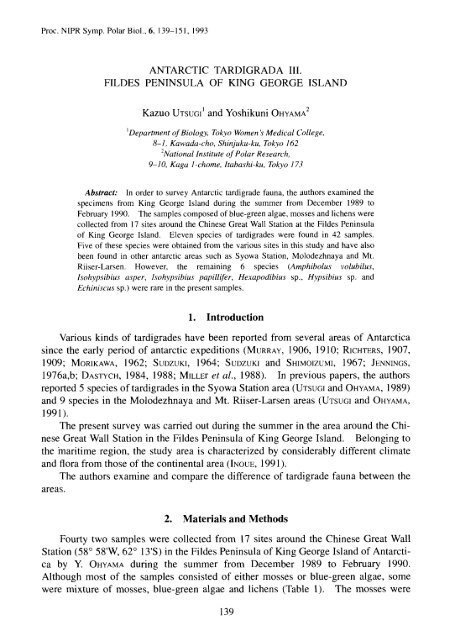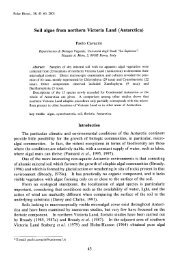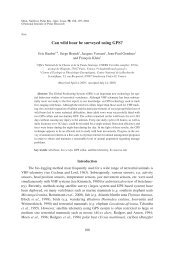ANTARCTIC TARDIGRADA 111. FILDES PENINSULA OF KING ...
ANTARCTIC TARDIGRADA 111. FILDES PENINSULA OF KING ...
ANTARCTIC TARDIGRADA 111. FILDES PENINSULA OF KING ...
Create successful ePaper yourself
Turn your PDF publications into a flip-book with our unique Google optimized e-Paper software.
Proc. NIPR Symp. Polar Biol., 6, 139-151, 1993<br />
<strong>ANTARCTIC</strong> <strong>TARDIGRADA</strong> <strong>111.</strong><br />
<strong>FILDES</strong> <strong>PENINSULA</strong> <strong>OF</strong> <strong>KING</strong> GEORGE ISLAND<br />
Kazuo UTSUGI' and Yoshikuni OHYAMA~<br />
~e~artment of Biology, Tokyo Women's Medical College,<br />
8-1, Kawadu-cho, Shinjuku-ku, Tokyo 162<br />
~ational Institute of Polar Research,<br />
9-10, Kaga I-chome, Itabushi-ku, Tokyo 173<br />
Abstract: In order to survey Antarctic tardigrade fauna, the authors examined the<br />
specimens from King George Island during the summer from December 1989 to<br />
February 1990. The samples composed of blue-green algae, mosses and lichens were<br />
collected from 17 sites around the Chinese Great Wall Station at the Fildes Peninsula<br />
of King George Island. Eleven species of tardigrades were found in 42 samples.<br />
Five of these species were obtained from the various sites in this study and have also<br />
been found in other antarctic areas such as Syowa Station, Molodezhnaya and Mt.<br />
Riiser-Larsen. However, the remaining 6 species (Amphibolus volubilus,<br />
Isohypsibius asper, Isohypsibius pupillifer, Hexapodibius sp., Hypsibius sp. and<br />
Echiniscus sp.) were rare in the present samples.<br />
1. Introduction<br />
Various kinds of tardigrades have been reported from several areas of Antarctica<br />
since the early period of antarctic expeditions (MURRAY, 1906, 19 10; RICHTERS, 1907,<br />
1909; MORIKAWA, 1962; SUDZUKI, 1964; SUDZUKI and SHIMOIZUMI, 1967; JENNINGS,<br />
1976a,b; DASTYCH, 1984, 1988; MILLE~ et al., 1988). In previous papers, the authors<br />
reported 5 species of tardigrades in the Syowa Station area (UTSUGI and OHYAMA, 1989)<br />
and 9 species in the Molodezhnaya and Mt. Riiser-Larsen areas (UTSUGI and OHYAMA,<br />
1991).<br />
The present survey was carried out during the summer in the area around the Chinese<br />
Great Wall Station in the Fildes Peninsula of King George Island. Belonging to<br />
the maritime region, the study area is characterized by considerably different climate<br />
and flora from those of the continental area (INOUE, 1991).<br />
The authors examine and compare the difference of tardigrade fauna between the<br />
areas.<br />
2. Materials and Methods<br />
Fourty two samples were collected from 17 sites around the Chinese Great Wall<br />
Station (58' 58'W, 62' 13's) in the Fildes Peninsula of King George Island of Antarctica<br />
by Y. OHYAMA during the summer from December 1989 to February 1990.<br />
Although most of the samples consisted of either mosses or blue-green algae, some<br />
were mixture of mosses, blue-green algae and lichens (Table 1). The mosses were
140 K. UTSUGI and Y. OHYAMA<br />
mainly Drepanocladus uncinatus, Bryum pseudotriquetrum, Polytrichurn alpinum and<br />
Calliergidum sp. Thread-like alga or Nostoc sp. was the most dominant species of blue-<br />
green algae. The lichens were not identifiable here.<br />
Tardigrades were extracted after macerating these samples in water and fixed-<br />
stored in ethanol. To examine the details of the animals, the fixed tardigrades were<br />
mounted on slides with Gum-chloral for microscopic observation. A scanning elec-<br />
tron microscope was also used to examine the surface structure of some species.<br />
3. Results<br />
The seventeen study sites are shown in Fig. 1. The occurrence of tardigrades at<br />
every site is summarized in Table 2. The characteristics of each species are described<br />
below.<br />
Fig. I. Locations of sampling sites: a. Arrow indicates survey areas in Antarctica; b. place for<br />
the present study; c. (9) and (A) mean sampling sites (Nos. 1-1 7) and the Chinese Great<br />
Wall Station, respectively.
Antarctic Tardigrada 111<br />
Class Heterotardigrada MARCUS, 1927<br />
Echiniscus kerguelensis RIGHTERS, 1904<br />
The characteristics of this species were described in a previous paper (UTSUGI and<br />
OHYAMA, 199 1).<br />
The present specimens were obtained from 7 sites (Nos. 1, 2, 3, 8, 11, 12 and 13).<br />
Echiniscus sp.<br />
(Fig. 2a-b)<br />
Body 130 to 150 pn in length. Body color unknown because of fixed specimen.<br />
Eyespots dark brown. Surface sculpture of each plate small granules irregularly<br />
arranged. Cirrus A long (40 pm in 142 pm specimen). Internal and external<br />
peribuccal cirri present. Lateral appendages posterior to cirri A on C and E very long<br />
0<br />
Fildes Peninsula of<br />
King George Island<br />
Fig. 1. (Continued).<br />
2'<br />
3' 4
142 K. UTSUGI and Y. OHYAMA<br />
Site<br />
number<br />
Table 1. Collecting data in the Fildes Peninsula of King George Island.<br />
- -- - - --pp---<br />
- ---<br />
- - --- -p<br />
Date Altitude Flora<br />
-<br />
1 '90.11.11.
Antarctic Tardigrada I11 143<br />
number and positions of appendages. But the length of each appendage of the present<br />
specimen is longer than JENNINGS (1976a) as shown in the following ratio (present to<br />
JENNINGS): appendage C, 60 to 35 pm; Cd, 60 to 45 pm; Dd, 7 pn to vestige; E, 128<br />
to 87 pm and further body length, 142 to 109 p.<br />
J. MURRAY (1906) suggested that the length of appendages may change during the<br />
development. But the present species resembles undetermined species E. sp. (J. MUR-<br />
RAY'S plate I. Fig. 2) as well. Therefore, there still remains a possibility that this<br />
species may be new to science.<br />
Fig. 2. Echiniscus sp.: a. Dorsal view; cuticular sculptures shown only on for right half. A, B,<br />
C, Cd, D, Dd and E indicate positions of appendages; b. external view of leg IV, with single<br />
papilla, dentate collar and claws.<br />
Class Eutardigrada MARCUS, 1927<br />
Macrobiotus harmsworthi J. MURRAY, 1907<br />
The characteristics of this species were described in a previous paper (UTSUGI and<br />
OHYAMA, 1989). The present specimens were obtained from 7 sites (Nos. 2, 7, 9, 12,<br />
14, 15 and 17).<br />
Amphibolus volubilus DURANTE PASA et MAUCCI, 1975<br />
(Fig. 3a-d)<br />
Body 470-660 pm in length. Eyespots present. Cuticle smooth. Mouth encircled<br />
by lamellae. Mouth tube short (70 pm), wide (6 pm). Pharyngeal bulb oval,<br />
with apophysis and two long rod-like macroplacoids. Microplacoid absent. First<br />
macroplacoid longer than second, with short projection at midpoint. Second<br />
macroplacoid with small node at posterior part. Doubleclaws of each leg large, of
144 K. UTSUGI and Y. OHYAMA<br />
Fig. 3. Amphibolus volubilus: a. Left lateral view by scanning electron microscope (SEM); b.<br />
ventral view; c. mouth apparatus; d. doubleclaws of leg III.<br />
almost the same shape. Both branches thick and curved, secondary branch at obtuse<br />
angle to primary one. At base of claws cuticular tract present. The present speci-<br />
mens were obtained from 6 sites (Nos. 4,6,7, 10, 11, and 17).<br />
Hypsibius arcticus J. MURRAY, 1907<br />
The characteristics of this species were described in a previous paper (UTSUGI and<br />
OHYAMA, 1989). The present specimens were widely obtained from 15 sites (except<br />
Nos. 1 and 14 of 17 sites).<br />
Hypsibius sp.<br />
(Fig. 4a-e)<br />
Body 316 pm in length. Body color unknown but transparent in fixed specimens.<br />
Cuticle smooth. Eyespots present. Mouth tube straight, ca. 34 pm in length, 2 pm<br />
in diameter. Pharyngeal bulb round; apophysis present; macroplacoids two in num-<br />
ber, rod-like in shape, of which first one has tiny constriction at midpoint and longer<br />
than second. Microplacoid absent.<br />
Doubleclaws of each leg considerably different in shape; primary branch of outside<br />
claw straight, extraordinarily long and slender (ca. 30 pm in 316 pm specimen); sec-<br />
ondary branch curved, thick, short (ca. 12 pm) and separated from primary one at base.
Antarctic Tardigrada 111 145<br />
Fig. 4. Hypsibius sp.: a and b. Ventral view; c. mouth apparatus; d. doubleclaws of leg III; e.<br />
doubleclaws of leg IV.<br />
Secondary branch of inside claw not separated, short at base and at obtuse angle to primary<br />
one. Thick cuticular bar present at base of each of doubleclaws.<br />
For this species, only one specimen was obtained from a Drepanocladus uncinatus<br />
moss sample collected at site No. 4.<br />
Remarks: Hypsibius sp. is similar to H. cataphractus MAUCCI, 1974. The former<br />
is, however, different from the latter in regard of the following two characteristics;<br />
H. sp. with a pair of eyespots and with cuticular surface being smooth, whereas H. cataphractus<br />
without eyespots and with fine granular structures on the cuticular surface.<br />
This species is probably new to science, but it remains undescribed here, because of the<br />
deficient number of specimens.<br />
Isohypsibius asper J. MURRAY,<br />
1905<br />
(Fig. 5a-d)<br />
Body 306-490 pn in length. Eyespots present. Dense small hemispherical pro-<br />
jections irregularly dispersed on dorsal and lateral surfaces of cuticle. Mouth tube<br />
narrow, short. Pharyngeal bulb oval. Apophysis small. Three macroplacoids
K. UTSUGI and Y. OHYAMA<br />
Fig. 5. Isohypsibius asper: a. Left lateral view; b. mouth apparatus; c and d. doubleclaws of legs<br />
I/ and IV, respectively.<br />
short, rod-like, of which first one rather round. Microplacoid absent. Doubleclaws<br />
of each leg large. Size of claws increases gradually from anterior to posterior legs.<br />
Secondary branch at obtuse angle with primary one. Each claw with lunule at base.<br />
The present specimens were obtained from 3 sites (Nos. 1, 2 and 12).<br />
Isohypsibius papillifer J. MURRAY, 1905<br />
(Fig. 6a-e)<br />
Body 170 pm in length. Eyespots present. Many conical papillae arranged in<br />
10 transverse bands of cuticle. Number of papillae on each band in order from<br />
cephalic to caudal part; 2, 6, 6, 6, 6, 6, 2, 6, 4 and 4. Mouth tube narrow, pharyngeal<br />
bulb oval. Apophysis present. Three macroplacoids short, rod-like and almost in<br />
the same size. Microplacoid absent. Both shape and size of doubleclaws similar<br />
among legs. Secondary branch at obtuse angle with primary one.<br />
The present specimens were obtained from 2 sites (Nos. 12 and 13).<br />
Diphascon (D.) alpinum J. MURRAY,<br />
1906<br />
(Fig. 7a-d)<br />
Body 240 pm in length. Cuticle smooth. Eyespots absent. Mouth tube<br />
straight and narrow, (1 pm in diameter, 20 pm in length) with drop-shaped structure at<br />
dorsal posterior edge. Pharyngeal tube long and curved, also narrow, 1 {im. in diame-<br />
ter, 44 ,un in length. Pharyngeal bulb short oval (28 x 22 pm in 240 pm specimen).<br />
Small apophysis and three macroplacoids present. Macroplacoid short rod-like of
Antarctic Tardigrada I11 147<br />
Fig. 6. Isohypsibius papillifer: a. Dorsal view showing conical papillae, by scanning electron<br />
microscope (SEM); b. left lateral view; c. mouth apparatus; d and e. doubleclaws of legs 111<br />
and IV.<br />
which first is shortest (2 pm), and other two equal (3 p). Microplacoid and septu-<br />
lum present. External and internal doubleclaws of each leg different in shape, being<br />
"Hypsibius type".<br />
The present specimens were obtained from 3 sites (Nos. 2,8 and 11).<br />
Diphascon (D.) higginsi BINDA,<br />
197 1<br />
(Fig. 8a-d)<br />
Body 143-382 pm in length. Cuticle smooth. Eyespots absent. Mouth tube<br />
straight, ca. 20 pm long, and pharyngeal tube slightly curved, ca. 30 pm long, narrow.<br />
Pharyngeal bulb elliptical (32 x 22 pm in 248 pm specimen), with a small apophysis,<br />
three elongated macroplacoids, a rnicroplacoid and septulum. Length of macropla-<br />
coids in order from first to third one 4, 5 and 6 jm. Shape of external and internal<br />
doubleclaws different from each other, being "Hypsibius type". At base of internal<br />
claw of anterior three pairs of leg, thin cuticular bar present.<br />
The present specimens were obtained from 3 sites (Nos. 7,8, and 14).
Fig. 7. Diphascon (D.) alpinum: a. Ventral<br />
view; b. mouth apparatus (lateral<br />
view); c and d. doubleclaws of legs 111<br />
and IV, respectively.<br />
K. UTSUGI and Y. OHYAMA<br />
Fig. 8. Diphascon (D.) higginsi: a. Left later-<br />
al view; b. mouth apparatus; c and d.<br />
doubleclaws of legs 111 and IV, respec-<br />
tively.<br />
Hexapodibius sp.<br />
(Fig. 9a-f)<br />
Body 420 to 607 pm in length. Eyespots present. Small conical papillae<br />
arranged in several transverse bands of cuticle. Number of papillae on a band 2-12,<br />
varying with band. Papillae developed dorso-laterally, but reaching to ventral side in<br />
some bands. Anterior part of mouth tube curved ventrally. Pharyngeal bulb round,<br />
with apophysis and three macroplacoid. Microplacoid absent. First and second<br />
macroplacoids short, rod-like (6 and 5 pm in length), third one longest (8 pn in 607<br />
pm specimen) and with a tiny constriction at posterior end. Internal and external<br />
claws developed on anterior three pairs of legs are the same shape. Primary branch<br />
long, secondary branch short, at obtuse angle with primary one. Fourth pair of legs<br />
very short; claws considerably vestigeal, short hook-like or absent.<br />
The present specimens were obtained from only one site (No. 8) close to the Chi-<br />
nese Great Wall Station.<br />
Remarks: Hexapodibius sp. has peculiar small conical papillae in the transverse<br />
bands on the dorsal to lateral cuticular body surface, whereas the other six congeneric<br />
species lack any papillae or projections on body surface. It is, therefore, possibly new<br />
species of this genus. But it is not described here, until the additional specimens will
Antarctic Tardigrada I11 149<br />
Fig. 9. Hexapodibius sp.: a. Left lateral view, by phase contrast microscope; b. left lateral view<br />
showing conical papillae on cuticular surface; c. mouth apparatus; d and e. doubleclaws of<br />
legs II and III, respective1y;f. vestigial doubleclaws of leg IV<br />
be available.<br />
4. Discussion<br />
In the present survey, the tardigrade fauna was examined in some places in King<br />
George Island, the places consisting of different kinds of environmental conditions. It<br />
is conceivable that King George Island is more fruitful in flora than the other areas of<br />
Antarctica, because of its maritime climate (INOUE, 1991). Comparison of the present<br />
results with those of previous reports, indicates that King George Island possesses the<br />
richest fauna (Table 3).<br />
The authors found 11 species of tardigrades in this study (Table 2), of which 5<br />
species (Hypsibius arcticus, Diphuscon (D.) alpinum, Diphascon (D) higginsi, Macrobiotus<br />
harmsworthi and Echiniscus kerguelensis) are distributed widely in Antarctica<br />
and other areas of the world. However, the other 6 species (Amphibolus volubilus,<br />
Isohypsibius asper, Isohypsibius papillifer, Hypsibius sp., Hexapodibius sp. and<br />
Echiniscus sp.) were rarely found in this study, of which the later 3 species have sever-
150 K. UTSUGI and Y. OHYAMA<br />
Table 3.<br />
---- - - - --- - - -- -- - - - - -<br />
Tardzgrade fauna zn four Antarctic areas.<br />
Tardigrades<br />
Syowa<br />
Station<br />
Molodezhnaya<br />
Mt. Riiser-<br />
Larsen<br />
King George<br />
Island<br />
Heterotardigrada<br />
Echiniscus kerguelensis 0<br />
E. sp.<br />
Pseudechiniscus sp. 0<br />
Eutardigrada<br />
Macrobiotus harmsworthi 0<br />
M. harmsworthi coronatus 0<br />
M. montanus 0<br />
Amphibolus volubilus<br />
Hypsibius antarcticus 0<br />
H. arcticus 0<br />
H. sp.<br />
Isohypsibius asper<br />
I. pupillifer<br />
I. saracenus<br />
Diphascon (D.) alpinum<br />
D. chilenensis 0<br />
D. conjungens 0<br />
D. ongulensis<br />
D. higginsi<br />
Hexapodibius sp.<br />
Milnesium tardigradum 0<br />
a1 different characteristics from those of the congeneric other species.<br />
Acknowledgments<br />
The authors wish to express their thanks to Mr. M. HOOVER for reviewing the<br />
manuscript.<br />
References<br />
DASTYCH, H. (1984): The tardigrada from Antarctic with descriptions of several new species. Acta Zool.<br />
Cracov., 27, 377436.<br />
DASTYCH, H. (1988): The tardigrada of Poland. Monografie Fauny Poliski, 16,255 p.<br />
INOUE, M. (1991): Ecological notes on the differences in flora and habitat of lichens between the Syowa<br />
Station area in continental Antarctic and King George Island in maritime Antarctic.<br />
Symp. Polar Biol., 4, 91-106.<br />
Proc. NIPR<br />
JENNINGS, P. G. (1976a): The tardigrada of Signey Island, South Orkney Island with a note on the Rotifera.<br />
Br. Antarct. Surv. Bull., 44, 1-25.<br />
JENNINGS, P. G. (1976b): Tardigrada from the Antarctic Peninsula and Scotia Ridge region. Br. Antarct.<br />
Surv. Bull., 44, 77-95.<br />
MILLER, J. D., HORNE, P., HEATWOLE, H., MILLER, W. R. and BRIDGES, L. (1988): A survey of the terrestrial<br />
tardigrada of the Vestfold Hills, Antarctica. Hydrobiologia, 165, 197-208.<br />
MORIKAWA, K. (1962): Notes on some tardigrada from the Antarctic region. Biol. Results Jpn. Antarct.<br />
Res. Exped. (JARE), 17, 3-7.
Antarctic Tardigrada 111 151<br />
MURRAY, J. (1906): Scottish National Antarctic Expedition; Tardigrada of South Orkneys. Trans. R. Soc.<br />
Edinburgh, 45, (pt. 2), 323-339.<br />
MURRAY, J. (19 10): Tardigrada. Br. Antarct. Exped. 1907-1909. Rep. Sci. Invest. Biol., 1, 83-1 85.<br />
RIGHTERS, F. (1907): Antarktische Tardigraden. Zool. Anz., 31,915-916.<br />
RIGHTERS, F. (1909): Tardigraden unter 77 S. Br. Zool. Anz., 34,604-606.<br />
SUDZUKI, M. (1964): On the microfauna of the Antarctic region. I. Moss-water community at<br />
Langhovde. Jap. Antarct. Res. Exped. Sci. Rep., Ser. E, 19, 14. SUDZUKI, M. and SHIMOIZUMI, J. (1967): On the fresh-water micro-fauna of the Antarctic region. 11. Stability<br />
of faunistic composition of Antarctic microorganisms.<br />
Spec. Issue, 1, 216-235.<br />
Jap. Antarct. Res. Exped. Sci. Rep.,<br />
UTSUGI, K. and OHYAMA, Y. (1989): Antarctic tardigrada. Proc. NIPR Symp. Polar Biol., 2, 190-197.<br />
UTSUGI, K. and OHYAMA, Y. (1991): Antarctic tardigrada 11. Molodezhnaya and Mt. Riiser-Larsen areas.<br />
Proc. NIPR Symp. Polar Biol., 4, 161-170.<br />
(Received May 6, 1992; Revised manuscript received August 13, 1992)




